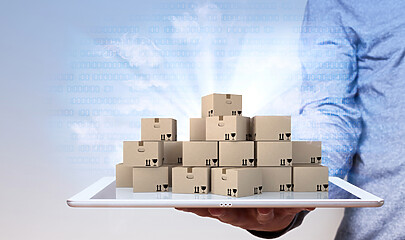197 million. That’s the amount of visitors the online platform has every single month. For people who are deciding whether to start selling on Amazon, this number of potential buyers is often the reason that makes them decide that it’s worth a shot. Other reasons are of course the easy setup, the flexibility that comes with working in e-commerce, maybe even one of the videos floating around social media that depict the grand and care-free life of really successful Amazon sellers. If you’re like us, you might have asked yourself several questions when watching these videos: “What items does that person sell? Where are these products sourced? Why is this person on a boat? What tools does he/she use?” All of these questions (more or less) are important in regard to selling successfully on Amazon and will be addressed in this article.
Let’s start by subdividing these questions into several parts:
- What to Do Before Selling on Amazon
- Setting up Your Amazon Selling Account
- Monitoring, Optimization, Expansion
Nut sure about selling on Amazon? Maybe eBay is better? Read this blog post to get the inside scoop: “Selling on Amazon vs. eBay: Make Your Choice!“
Part 1 – What to Do Before Selling on Amazon
A professional seller account won’t get you far in the Amazon business if your products aren’t flying off the shelves and even if your items sell well, they are not worth your time if they don’t rake in a solid margin after sourcing and shipping. Investing time and researching what sells best on Amazon, what shipping method to use and what fees to consider is definitely the preferable option to “let’s just try this and see what happens.”
Amazon Selling 101 – Product Selection
Wondering what to sell on Amazon? Then you’re off to a good start. You can imagine that it’s no longer the wisest idea to invest your hard-earned money in a container load of Fidget Spinners. But what are the top selling items on Amazon and what categories are popular with buyers?
Your best bet is to check different sources regularly regarding what products are popular at the moment. Amazon: Best Sellers, for example, shows you a list of best-selling products (based on sales) and is updated hourly. Alibaba and GlobalSources are two well-known sourcing companies that also show you what products are hot at the moment on their website.
Here is an up to date (March 2021) list of what categories are selling best at Amazon:
- Apparel & Accessories
- Cosmetics
- Electronics
- Skin Care
- Hair Care
- Health
- Home Decor
- Home and Garden
- Nutrition
- Pet
- Supplements
- Kids & Toys
For Amazon selling, this product list is not exhaustive. Many best selling products on Amazon change constantly and are subject to trends and seasons.
Transfer as much of your expertise as possible to Amazon by selling items you already know in and out. Upgrade your Amazon listing by creating high level products descriptions and providing the customers with in-depth knowledge when they ask a question. Let the customers know that they are buying from an expert rather than from someone looking to make a quick deal.
With over 2.2 billion monthly visits and a 40 % share of U.S. e-commerce, Amazon remains the ultimate launchpad for anyone looking to succeed in online retail. Whether you’re building a side hustle or scaling a private label brand, Amazon FBA in 2025 …
Selling on Amazon – Wholesale or Private Label?
One thing in advance: There is no blanket answer as to whether Private Label or Wholesale generates more revenue when selling on Amazon. It is much rather a matter of what interests you have as a seller and what goals you are pursuing. Finding out which model suits your interests the best is therefore extremely important.
Amazon Selling with Private Label
Selling over Private Label means that you have to establish your own brand. This includes that you are responsible for expanding the brand and raising awareness. You also take responsibility for the products sold under this brand.
How do you establish your own brand? The good news is that nowadays nobody has to build an own backyard factory in order to create a new product.
Let’s take a real life example: Through your research you have found out that toothbrushes are selling really well in the marketplaces you are active in. You visit a platform like Alibaba or GlobalSources, choose and order a toothbrush you deem fit and want to sell under your Private Label. You order personalized packaging and the printing of your logo on the products and voilà, you created your own toothbrush brand.
Selling your brand is beneficial for you because it means that you now have your own listing and therefore do not have to compete for the Buy Box with other sellers. The challenge you’re faced with is that nobody knows your product and you have to invest a sizable effort into marketing.
Have you ever heard the term “Amazon Hijacking”? Well, this is something that is currently happening to sellers when some individuals are willing to profit off the efforts of others. However, listing hijackers can only achieve their goal if the seller is unaware of their presence in the marketplace. In this article, you will learn how to save your Amazon business from hijacking.
Over the years, Amazon Private Label has established itself as a very successful business model for E-commerce entrepreneurs around the globe. With a few tricks, the right niche, a suitable target group, the right calculations and a little bit of luck, your tidy profit is only a few mouse clicks away. But what exactly is Private Label on Amazon nowadays? Let’s take a closer look here!
Amazon Selling with Wholesale
In contrast to Private Label products, already established brands can be resold when using the Wholesale model. Circling back to our toothbrush example. You decide that going with an already well-known brand will bring you more revenue in the long run. You buy Oral-B toothbrushes in bulk, knowing that customers will specifically search for this brand when interested in toothbrushes. You register as a seller of this specific article and are good to go.
In this case, you have the benefit of being able to sell a well-known product that customers actively look for. The challenge here is that you have to share your listing with other sellers and constantly have to compete for the Buy Box.
Many sellers who want to gain a foothold on Amazon are faced with the question of which strategy works best for them. Decisions have to be made not only in regard to the regular factors such as price, quality, or shipping costs, but also take into account t…
Are you planning to sell Amazon Wholesale products? Well, the good news is that getting started is very easy because a seller account can be created in a few minutes. the main challenge, however, is product sourcing. The main two options at your disposal ar…
Amazon Selling Fees and Costs – Is Selling on Amazon Profitable?
The “solid margin” we just spoke about is also a result of taking into account what you will have to spend in order to run your shop successfully. Here are three expenses you will need to take into account when selling on Amazon.
Selling Plan
The Amazon fees for selling depend on whether you are selling professionally or as an individual. While Amazon selling as an individual will cost you 0.75£ (0.99$ in the US) per unit sold, the professional sellers have a pricing plan of 25£ (39.99$ in the US) a month and can sell as many items as they want.
Referral Fees
Amazon charges a referral fee for each item sold. This is fair because you’re using their platform to reach millions of potential customers and a similar fee would also be charged if you were selling on a regular – non-digital – marketplace. The amount you pay depends on the product category. Most referral fees are between 8% and 15%. Exceptions up to 20 % can occur if you sell jewelry, handbags, shoes or sunglasses at a certain price. The most noteworthy exception is the 45% referral fee if you sell Amazon Device accessories.
Fulfillment Fees
Fulfillment fees depend on whether you plan to ship products yourself, or use Fulfillment by Amazon (FBA) to handle your logistics and offer Prime shipping for your products.
Selling on Amazon with FBA
The Amazon FBA fee per unit includes picking and packing your orders, shipping and handling, customer service, and product returns by the customer. The fee is always based on the weight and dimensions of your product. Different fees for selling with Amazon FBA apply if you sell apparel.
Selling on Amazon with FBM
While sellers with the professional plan (25£) set their own shipping rates (except for books, music, video, and DVD products). When a customer buys your product, you receive a credit from Amazon that matches the shipping rate. Keep in mind that the referral fee is calculated from the total sale price, including the item price, shipping cost, and any gift-wrapping charges.
Sellers with the Individual plan use Amazon’s set shipping rates for all products. Individual sellers have to ship orders at the set rates even if the shipping credit is less than the total shipping costs, so it’s important to price items in a way that makes sure you’ll earn a profit.
You can find further pricing details here.
Amazon Selling – Costs and Services
There may be other additional costs that you have to deal with in specific situations for example when refunds occur or when you have a high volume of active listings that haven’t been sold for 12 months.
You guessed it, at the end of the day there are a lot of costs associated with Amazon selling. This cost calculator can help you get a quick overview if your business idea has the potential to make a lot of money on Amazon.
Part 2 – Setting up Your Amazon Selling Account
You’ve successfully completed the first phase and are now looking forward to setting up your selling account on Amazon. How to start, though? Selling on Amazon requires that you ask yourself several important questions. What shipping method is best in your situation? Is the individual or professional seller account the correct choice for you? Let’s get started with the shipping method.
Selling on Amazon – FBA, FBM, or Prime by Seller?
How you ship your product not only determines when your customers receive their goods, it can also have a big impact on your sales. When selling on Amazon, you basically have three different options on how to handle your fulfillment.
Fulfillment by Amazon (FBA)
What is Amazon FBA? When selling on the online platform, this is a question you will have to address sooner or later. In short: Amazon FBA means that you pay a fee to Amazon, and in return Amazon takes over your shipping and customer support.
Since the online giant places a very high value on the perfect customer experience, Amazon has developed a shipping method that ensures the highest possible customer satisfaction: Fulfillment by Amazon (FBA). For the end customer, this means free and fast shipping, excellent service, an easy return process, and much more. When selling on Amazon, you benefit from increased customer loyalty, the Prime Label and the indication ”Shipped by Amazon”. Selling with Amazon Prime also makes you more attractive to new customers, since everyone knows that you will receive quick and reliable shipping with Amazon. As a seller, you are able to select this option and send your goods to Amazon‘s logistics centers. The shipping giant then proceeds to take over from there on out.
The numbers alone prove that selling with Amazon FBA (Fulfillment by Amazon) has become a no-brainer for many professional Amazon merchants – 75% of the top 100’000 sellers in the United States and about 2/3 of all third-party sellers on Amazon use th…
Fulfillment by Merchant (FBM)
Alternatively you can take care of fulfillment independently, handling all processes from A to Z yourself. When selling on Amazon, this has the benefit that you stay in full control of all your processes. This is important if you want to keep in close contact with your buyers through customer support. However, these products will not receive the coveted ”Prime Label“.
Prime by Seller
In this alternative, Amazon provides the seller with specific information regarding the order (e.g. the specification of which sender is chosen). Naturally, these products also display the popular Prime Label, helping you address the largest Amazon buyer group: the Prime customers.
The benefit is that you are able to stay in complete control of all processes and sell under the Prime label. The challenge is keeping up with the very high standards that Amazon sets.
Selling on Amazon – Individual or Professional Seller Account?
When selling your goods on Amazon, you can either do so as a professional or individual seller. If you want to find out which account is best for you, just ask yourself the following question: Do you plan on selling more than 40 units per month? If the answer is yes, then registering as a professional seller is worth it – at least from a financial perspective. You can find more details regarding the fees and costs for both models under “Selling Plan”.
Part 3 – Monitoring, Optimization, Expansion
Congratulations! You have completed phase 2 and are now successfully selling your products on Amazon. The next question is: How do you stay successful at it?
Many Amazon sellers are on a tight schedule. New goods have to be purchased, the warehouse has to be filled, customers want to receive their products. In addition, the product page must be maintained and the competition analysed. With so many tasks, you are…
We all know that social media has never been the best source for unbiased, honest and objective information. It is therefore not surprising that it is specifically on these platforms that you can currently find one or the other “Amazon coach” pr…
Selling on Amazon – Monitoring
As your e-commerce business grows, so will the amount of data you have to monitor in order to stay well-informed. You will have to keep an eye on your offers and sales, manage your listings, communicate with customers, manage your inventory, authorize returns and refunds and the list goes on. This is indeed a lot of work. Luckily, there are programs and apps designed to make your life easier in that regard. Amazon Seller Central is the main platform for handling this part of your business. It’s a unified selling platform that allows you to do all the above mentioned actions from the comfort of your computer. If you’re thinking: “I bet there’s also some sort of Amazon selling app for this kind of stuff,” you are absolutely correct. Amazon Seller is an app by Amazon that also lets you monitor all the aforementioned factors when you don’t have a computer at hand.
Selling on Amazon – Optimization
If things are going well, try finding ways to make them go even better. A good way to do this is by improving your Buy Box share and through effective product placement.
Learn here how you can optimize your Amazon product listings and why a PIM tool can be helpful!
Winning the Buy Box and Why it Is Necessary
The Buy Box is regularly known as the “Add to Cart” field. It is so popular amongst sellers because 90% of the customers make their purchases over this button and the Buy Box can only hold one seller. The algorithm that wins you the Buy Box is unknown to everyone except Amazon. What we can tell you, however, is that there are several metrics that will guarantee you higher chances of winning the Buy Box.
Selling on Amazon will require you to pay a lot of attention to one of the most important metrics: the final price. This includes the price of your product plus shipping costs and is one of the highly relevant for winning the Buy Box. During your research on Amazon’s platform, you will have noticed that the prices change multiple times a day. Often, winning the Buy Box is a matter of a few cents, which is why the prices change so dynamically.
Manually, this would indeed be a very daunting task. With the right repricing solution however, this necessary task requires no time at all.
Ramp up Your Reviews
In e-commerce, feedback is just as important as anywhere else. What’s the first thing you do when you’re planning on purchasing something you have had no experience with before? You go and look at what other buyers have said about the product. Selling on Amazon means that reviews will be a vital part of your business model because they determine whether your products sell well or remain shelf warmers in your garage. There are many ways to increase the number of reviews on your product pages (buying them is not an option, by the way) and also a couple of tools that can help you automate the process. Fake reviews on Amazon are also a big problem. Be sure to monitor your reviews closely and report anything that seems fishy to you. Remember that too many fake reviews will harm your product visibility in the search results.
You have an amazing product on Amazon, but your sales are stagnating despite its demand. Market research reveals the reason: while you get one or two reviews a week, your competition gets three times that, driving more traffic and sales. So, now you have to…
When you are looking to improve professionally, every business guide, podcast, or blog article will tell you the same thing: understand who you are up against. Click here to find out which steps you can take immediately.
Every kind of business, but especially the ones that sell on Amazon, relies heavily on customer reviews. For sellers and companies, getting Amazon seller reviews may be difficult. To prevent jeopardizing your account, it’s also crucial to grasp Amazon’s review criteria. In this article, we’ll go through the importance of Amazon reviews, and how to stay compliant with Amazon standards while looking for more reviews.
Selling on Amazon – Expansion
The one benefit about Amazon is that selling globally is a feat that can be accomplished with a fair amount of work and planning. With its huge customer base, the online platform is not only a gateway to multiple marketplaces, it also enables sellers to strengthen their Amazon business by being active internationally.
Here’s an example: Say you are planning to expand from selling on Amazon UK to selling in Europe. The European marketplaces alone will offer you several million more potential customers. What’s more, you can stabilize your products that are affected by seasonal or fluctuating demand. If the British spring is so rainy that only the toughest gardeners are drawn outside, the sale of your garden tools can continue on a Greek or Italian marketplace and can quickly make up for part of the drop in sales.
Final Thoughts
Is Amazon selling worth it? Here’s an honest answer: it depends. Selling on Amazon 99 % hard work and careful planning and 1 % celebrating your success (optionally by filming a how-to video on a rented boat). If you are willing to invest time, patience and money into this endeavor, you will succeed. If you believe that you will make a quick buck and your business idea bases solely on sourcing random and cheap products in Asia and selling them in the west, we wish you good luck. Because you will need it.
Start by researching products and getting in touch with people to source from. Once you have done that, make sure that your margin is still profitable after deducting all the fees and costs.
Once you have set up your shop, figure out your shipping method, whether you want to sell professionally or individually and align your Amazon selling technique and business model with the options Amazon provides for you.
Once you are up and running, make sure it stays that way. Keep your eyes and ears open for new opportunities and don’t shy back from automating your business with Amazon selling tools that are designed to save you time and money.
How Do I Find a Good Product?
When researching what product to sell next, be sure to look in the right places. Websites like GlobalSources or Alibaba are always a good place to start. Amazon also keeps a list of bestsellers which is updated hourly.
Should I Sell over Wholesale or Private Label?
Both options present their benefits and challenges.
As a Private Label seller, you benefit from having your own listing and don’t have to worry about the fierce Buy Box competition that Amazon is known for. The downside is that no one knows your product yet.
When selling Wholesale, you won’t have to put a lot of effort into marketing, since your products are already well-known. You will have to compete with other sellers for the Buy Box though which is a huge challenge in itself.
Is Amazon FBA the Right Choice for Me?
Since using Amazon FBA means that your customer service and shipping will be handled by Amazon, this option would make sense for people who don’t have any logistics installed in that regard. If, however, your customer support and shipping methods are already excellent, then you will have nothing to gain from using the Amazon FBA program and should look into Amazon FBM or Prime by Seller.
What Fees Do I have to Keep an Eye on?
At the end of the day, you will want to make a solid margin, why else would you invest all this time and money? Be sure to include the fees Amazon will charge you into the calculations for your final price. These include your selling plan, Amazon’s referral fees and fulfillment fees.
Image credits in order of appearance: © grapestock – stock.adobe.com / © wutzkoh – stock.adobe.com / © William W. Potter – stock.adobe.com
SELLERLOGIC Repricer
Maximize your revenue with your B2B and B2C offers using SELLERLOGIC's automated pricing strategies. Our AI-driven dynamic pricing control ensures you secure the Buy Box at the highest possible price, guaranteeing that you always have a competitive edge over your rivals.
SELLERLOGIC Lost & Found Full-Service
Audits every FBA transaction and identifies reimbursement claims resulting from FBA errors. Lost & Found manages the complete refund procedure, including troubleshooting, claim filing, and communication with Amazon. You always have full visibility of all refunds in your Lost & Found Full-Service dashboard.
SELLERLOGIC Business Analytics
Business Analytics for Amazon gives you an overview of your profitability - for your business, individual marketplaces, and all your products.



















